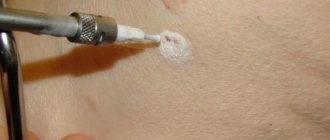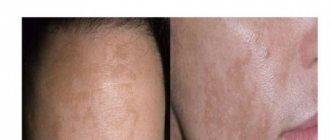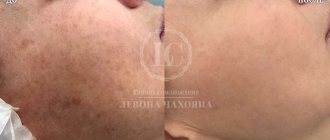Causes of growths under the tongue
Formations on the tissues of the tongue and oral mucosa appear when the growth mechanism of epithelial cells fails. This process is provoked mainly by condylomatosis or the so-called papilloma virus. The disease is considered insidious due to hidden symptoms at an early stage of development, which complicates early diagnosis. In addition, it is contagious, the virus is transmitted even through kisses and shared household items, not to mention closer contacts of partners (sex of different types).
Children can become infected with condylomatosis at birth from an infected mother, therefore, when the disease is detected in a pregnant woman, it is recommended to allow labor by cesarean section.
Etiology - causes of tongue cancer
The main cause of tumors on the tongue, like any other cancer, is a genetic malfunction in the cells.
In this case, these are epithelial cells - the tissue that forms the mucosa. Several main factors contributing to this process have been identified:
- Exposure to carcinogens. A huge amount of harmful substances is contained in cigarette smoke and chewing mixtures (nasvay, betel). It is in smokers and nasal users that cancer of this localization is most often diagnosed, and in men it is detected 3 times more often than in women. Alcohol increases the impact of carcinogens.
- Occupational hazards. The incidence of tongue cancer in people employed in hazardous industries is much higher. Salts of heavy metals (mercury, lead), asbestos, and petroleum products can also be classified as carcinogens by their nature.
- Photo: neoplasm on the tongue
Impact of viruses. Recent studies have proven a direct link between chronic viral infection and the incidence of cancer. Human papillomavirus, herpes simplex virus and HIV are capable of transforming the genome of cells, turning them into cancerous ones. According to statistics, up to 70% of women are carriers of HPV. The mechanism of oncogenic effects of viruses is associated with their ability to suppress antitumor genes.
- Chronic oral injuries. They may be associated with improper installation of dentures, improper treatment of fillings, or chronic biting of the mucous membrane.
Long-term exposure to these factors on the mucosa is accompanied by damage to the DNA structure of epithelial cells. As a result, papillary hyperplasia (excessive growth) develops, which looks like a thickening at the sides, or dysplasia (improper development) of the mucous membrane.
Further exposure to these causes leads to the development of precancerous conditions: leukoplakia, Bowen's disease, hyperkeratosis and papillomas. Subsequently, these conditions transform into oncology.
Symptoms
You can recognize a problem in the oral cavity by the following signs:
- seals, tubercles, small antennae or outgrowths form under the tongue, which are clearly visible upon visual inspection;
- the shape of the formation is filamentous or elliptical;
- the texture is soft and smooth, no peeling is observed;
- the color of the growth may be the same as the mucous membrane, or have a reddish, whitish tint;
- the formation is 2-20 mm in diameter.
What is
A lump is a formation of varying size, formed from the upper layers of the mucous membrane. The neoplasm may be white or red, as well as a bluish tint. Inside the cavity there is content consisting of lymph, blood clots, pus or pathologically altered cells.
A lump under the tongue often indicates a disease. The cause is identified based on external signs, examination of the tumor, and histological examination.
Treatment depends on the provoking factor and type of formation. Antibiotics and antiseptics are prescribed. Sometimes surgery is required.
There may be several reasons for the formation of a tumor. Most often this is damage to the mucous membrane or the development of other diseases. That is why it is important to promptly establish the cause of its occurrence, before the pathological process spreads to other tissues of the oral cavity.
Sometimes a lump in the area of the hyoid frenulum may indicate a mandibular ridge (torus).
Bone hyperplasia is in most cases benign and requires treatment only if it interferes with the installation of prostheses.
Dentist
Novikova Olga Alexandrovna
8 years of experience
Treatment is carried out after diagnostic testing and exclusion of malignancy, since a lump in the sublingual area may appear as a result of the development of oncology.
External manifestations (+photo)
Growths under the tongue in humans form in the form of warts, papillomas, and condylomas. All varieties are signs of the presence of VPI in the body. Their differences lie in the type of epithelium and external manifestation. Papillomas can be either protruding above the surface of the mucous membrane or flat with rough tissue. And condylomas always rise above the surface of the skin or mucous membrane with the help of a fairly high stalk.
Types of growths under the tongue:
Depending on the type and causes of formation, condylomas come in different colors:
- red;
- white;
- light with a yellow tint;
- pink;
- gray;
- from light to dark brown.
Growths in the oral cavity are most often localized in the following areas:
- on the mucous membrane under the tongue;
- on the bridle;
- on the gum under the tongue;
- on the inside of the tongue;
- along the rim of the tongue and other areas of the mucous membrane.
Treatment methods for tongue cancer
Regardless of the cause of tongue cancer, combination therapy is used to treat it, including the following methods:
- Surgery. The operation is aimed at radical removal of a malignant tumor: either partial resection (excision) of the tongue or its complete removal (glossectomy) is performed. In advanced cases, when the tumor has grown into the surrounding tissues, they are resected down to the bones of the lower jaw.
- Radiation therapy. There are remote therapy, when the tumor is irradiated at a distance with X-rays, and contact therapy (brachytherapy), when the radiation source (radioactive isotopes) is placed deep within the organ. Radiotherapy is performed both before and after surgery. The doctor determines how many sessions are needed.
- Polychemotherapy. It is used in advanced cases in the presence of distant metastases, when other methods cannot be used, or their effect is insufficient. Patients are treated with Cisplatin, Methotrexate and other drugs.
Surgeries in the later stages of the disease are often mutilating in nature - in some cases it is necessary to remove almost the entire lower jaw. After surgery, patients live with some restrictions. In order to create a satisfactory quality of life, they undergo reconstructive medical operations.
Diagnostics
Examination by an otolaryngologist
If characteristic growths are detected in the oral cavity, you should contact one of the recommended specialists (depending on the location of the focal zone):
- dentist;
- otolaryngologist;
- dermatovenerologist.
It would also be a good idea to visit an oncologist to rule out the possibility of developing a tumor of malignant origin.
Diagnosis of condylomatosis and other diseases associated with the formation of growths under the tongue consists of the following steps:
- visual examination by a doctor;
- taking anamnesis;
- laboratory research;
- histology.
How is the sublingual area treated?
Considering the above reasons, if you have the slightest pain in the sublingual space, you should immediately consult a doctor. The doctor will find out the source of the pain and determine a treatment regimen. In some cases, allergists and therapists provide treatment. But more often, pain in the floor of the mouth is treated by dentists.
In case of injury to the frenulum or the tissues of the area under the tongue, rinsing will be prescribed: with a solution of soda, romazulan, stomatophyte, hexoral, chlorophyllipt or iodinol. You should rinse your mouth according to the following schedule:
- morning and evening before bedtime;
- after meal.
The doctor also treats the area of injury with an antiseptic and anti-inflammatory drugs.
Inflammations caused by dental problems require immediate treatment - the specialists at Family Dentistry will get rid of caries, pulpitis or periodontitis and prescribe a course of anti-inflammatory drugs to cope with sublingual inflammation.
But one of the most dangerous diseases in the floor of the mouth is inflammation of the salivary glands. It is important to begin treatment before an abscess appears and complications develop. In this case, the doctor prescribes:
- antibacterial therapy - the doctor injects medicine into the gland and also prescribes a broader-spectrum antibiotic;
- drugs to activate saliva secretion - either a solution of potassium iodide or pilocarpine is used, sometimes regular lemon is used;
- hot dry compresses;
- physiotherapy course.
If the inflammation is advanced and pus appears or a stone has formed, the patient is sent to a surgeon, who cleans the gland cavity of pus and removes the stone.
Types of processes
Most often, flat or pointed warts form in the oral cavity:
- Flat formations have a small protrusion above the mucous membrane and tissues, their shape is predominantly round. Condyloma differs in color from the general background in a brighter shade, so identifying it is quite simple. It is quite dense to the touch and is localized on the lower part of the tongue and oral mucosa.
Flat build-up
- Pointed papillomas form individually in the form of nodules or as a whole family, which makes them similar to cauliflower. They are moderately soft and elastic to the touch.
Pointed growth
Another type of growth is condylomas lata, which are localized not only on the tongue, but also on other parts of the oral mucosa. The reason for their appearance is syphilis.
Stages of tongue cancer
There are several stages of the disease, each of which has its own distinctive features.
Initial stage of tongue cancer (first)
Photo: this is what the initial stage of tongue cancer looks like
It is characterized by an asymptomatic course - practically nothing bothers patients. It appears as whitish spots on the mucous membrane, the so-called papillary growths. They are often mistaken for plaque, which is located on the lateral surface of the muscular organ.
When examined, doctors often mistake these formations for manifestations of other diseases: glossitis or stomatitis. There is no pain at this stage.
Stage of clinical manifestations (second)
As the disease progresses, the “plaque” gradually turns into a lump on the tongue, which, if left untreated, transforms into a tumor on the tongue. At this stage, a pain syndrome appears; the pain is diffuse or local in nature, very often radiating to nearby organs (neck, temple, ears).
Patients at this stage often complain of bad breath, which is caused by infection and suppuration of the tumor. The clinical picture is accompanied by difficulty swallowing, articulation disorder, swelling and numbness of part of the tongue. Metastasis to surrounding tissues and nearby lymph nodes - submandibular, cervical - is possible.
Advanced degree (third)
It is possible to bring the disease to this stage if you completely ignore the symptoms of the initial and second stages of tongue cancer. It manifests itself as aggressive invasive (penetrating into the thickness of the organ and surrounding tissues) growth, accompanied by tissue decay.
Terminal stage (fourth)
In this phase, distant metastases occur - in the bones, liver, lungs. Treatment of advanced tongue cancer is not very successful and the prognosis is very doubtful. Patients who progress the disease to the terminal stage rarely live more than a year.
Treatment is only palliative - the fight against pain and cancer intoxication.
Drug treatment
A mandatory part of treatment is sanitation of the oral cavity.
To eliminate growths under the tongue with condylomatosis, complex treatment is used, which includes:
- taking antiviral drugs;
- the use of antiseptic solutions and ointments for local treatment of the affected area;
- carrying out complete sanitation of the oral cavity at the dentist (treatment of caries, inflammation of dentin, and other problems);
- consumption of a vitamin complex to strengthen the body’s protective functions;
- taking immunomodulatory drugs;
- removal of growths using surgery, a laser beam or radio waves.
During the period of therapy, it is important to reconsider your usual lifestyle and make adjustments to it, getting rid of bad habits and casual relationships. To speed up the healing process, you need to avoid irritating the mucous membranes with hot or too cold drinks and dishes. Hygiene procedures should be carried out regularly, at least 2 times a day, using high-quality cleaning products.
Popular antiviral drugs include:
- Acyclovir (tablets);
- Panavir (solution for intravenous injection);
- Isoprinosine (tablets);
- Allokin-Alpha;
- Alpizarin (tablets).
The following are considered effective immunomodulators: Derinat, Likopid, Immunomax, Polyoxidonium.
For local impact on the lesion, the following means are used:
- Podophyllin;
- Cryopharma;
- Lapis pencil;
- Solcoderm;
- Verrukacid et al.
When using local preparations, you need to carefully read the instructions so that during the treatment of papillomas you do not burn healthy mucosal tissue.
Removal methods
There are several ways to remove growths under the tongue. In each individual case, the specialist selects the best option, taking into account the localization of the formation and the extent of the affected area. Whatever method is used, it is complemented by antiviral therapy to prevent relapses. Only an integrated approach, including taking medications, will help get rid of the problem in the oral cavity.
| Treatment of growths under the tongue | |
| Method name | Process description |
| Surgical removal | An effective way to remove growth by cutting it off from soft tissue using surgical instruments: scalpel, scissors, electric knife, conchot. Sutures are subsequently placed on the wound. |
| Cryodestruction | The growths are removed using liquid nitrogen. The method copes with the task, but this type of influence can provoke malignancy of the formation, that is, have the opposite effect. |
| Laser removal | The essence of the method is to cut off the growth with a laser beam. The advantages of the method: quick and effective elimination of formations, absence of pain for the patient and bleeding, which prevents infection. The likelihood of relapse is very low; after the procedure, the process of cell regeneration is stimulated. |
| Radio wave therapy | The method is low-traumatic and painless; the procedure does not even require the use of a local anesthetic. Removal of growths occurs under the influence of high frequency radio waves. The specialist directs them to the base of the growth and cuts off the affected tissue. The rehabilitation period lasts 7-10 days. |
| Electrocoagulation | This method efficiently and quickly removes pedunculated growths on the tongue. The essence of the method is to throw a loop of special fiber over the formation and apply high-frequency current to the material. The hot fiber cuts off the growth, simultaneously soldering the microvessels, which prevents bleeding and infection of the wound. Electrocoagulation prevents further development of the virus. At the site of the removed growth, a crust forms, which after some time comes off on its own. |
| Galvanocaustics | The location of the small growth is cauterized with platinum wire heated under the influence of current. The method is fast, eliminating bleeding and infection of the wound. |
What to do at home if a growth appears - folk methods
In addition to traditional treatment of growths under the tongue, many patients use traditional recipes. It is impossible to replace treatment with a completely unconventional method, but nothing prevents you from trying it.
Popular folk recipes for growths under the tongue:
- daily rubbing of the formations with garlic juice or applying cloves of spice;
- lubricating newly appeared growths with egg white;
- treating affected areas with castor oil (using cotton swabs);
- rinse the mouth twice a day with decoctions of medicinal herbs (medicinal chamomile, string, sage, echinacea, etc.);
- ingesting rosehip decoction, freshly squeezed potato or carrot juice.
Any infections and viruses developing in the body signal a decrease in immunity, so during the treatment period you should take care of taking fresh vegetables and fruits. A good vitamin complex is also suitable for these purposes.
Before using an unconventional approach, you should consult your doctor to rule out contraindications.
Preventive measures
Use mouthwash after meals.
Preventing the development of a disease is always easier than fighting harmful microorganisms and the results of their vital activity. To prevent the formation of growths in the oral cavity, the following measures are recommended:
- perform hygienic cleaning of the mouth at least 2 times a day;
- after eating, use a mouthwash;
- develop a diet so that it contains mainly fresh vegetables and fruits (to strengthen the immune system);
- regularly visit the dentist for preventive examinations;
- do not borrow other people’s household items (dishes, towels, cosmetics);
- undergo an annual examination with an oncologist;
- lead an active lifestyle (if you work sedentarily, include morning exercises and twice-a-day workouts on simulators in your daily routine).
HPV vaccinations
HPV vaccine
You can protect yourself from the formation of growths in the oral cavity by getting vaccinated against the papilloma virus. There are many different rumors around this vaccine, but they have no basis in terms of effectiveness.
The product contains substances of organic origin that promote the production of cells in the body that resist the development of condylomatosis.
Effective means are used for vaccination:
- Cervarix;
- Gardasil.
These vaccines are not used in the treatment process; they are intended solely for preventive purposes. The procedure must be performed before sexual activity begins; the maximum age of the patient is 26 years. When using the product at an older age, the effectiveness decreases significantly.
One vaccine protects the body from the papilloma virus for 8 years.
Features of child treatment
The treatment strategy for growths under the tongue in children includes two main stages: improving the immune system and eliminating formations in the mouth.
There are difficulties in selecting agents for local action on papillomas due to the constant contact of the drug with saliva. Therefore, the first recommendation for children is to change their usual toothpaste to a professional product that has a bactericidal effect.
When choosing antiviral drugs, the priority is not effectiveness, but safety. The ideal option is a drug that contains a combination of ascorbic and rutic acids (for example, Ascorutin). Recommended immunomodulators include: Amiksin, Viferon.
When determining the most suitable method for removing papillomas, the accuracy and speed of the procedure, as well as the low level of risks, are taken into account.
Prevention
In order to prevent the development of any oral disease, you should follow the rules of hygiene. It is also important to choose the right toothbrush, since bristles that are too hard can injure the mucous membrane.
If an infectious disease develops, you should undergo the entire course of treatment, since the inflammatory process can spread throughout the body, reducing immunity and causing the formation of a lump.
A tumor under the tongue may indicate the development of serious diseases, such as oncology, or appear as a result of improper oral hygiene. When the first symptoms occur, you should contact your dentist, who will determine the cause and extent of the disease.











